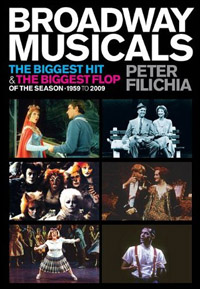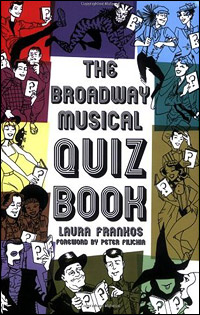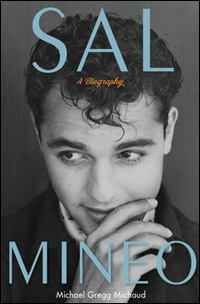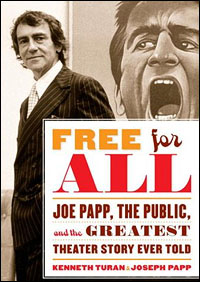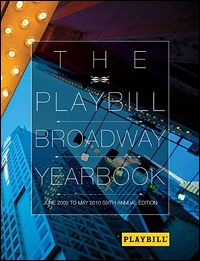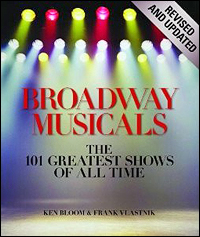*
Before we do go on to new business, let me reiterate that the best theatre book of the year, or the decade — and one of the not very many theatre books to be found on the best seller list in the last half century — is "Finishing the Hat: Collected Lyrics (1854-1981) with Attendant Comments, Principles, Heresies, Grudges, Whines and Anecdotes" by Stephen Sondheim [Knopf]. Since reading — or should I say devouring? — it two months ago, I find myself regularly returning to this worthy tome; the pages aren't dog-eared and coffee-stained yet, but give me time. You can read my thoughts on this book here; but really, just get it. (My editor tells me that he has bought five copies — so far — to give as gifts. Isn't that a good kind of friend to have on your holiday list?)
*
Next come twin stocking stuffers for Broadway fans who just can't get enough information about musical comedy. Peter Filichia, that prolific chronicler of the musical stage, has combed through the last half century to give us
Broadway Musicals: The Biggest Hit & The Biggest Flop of the Season, 1959-2009 [Applause]. The "Biggest Hit" is most usually a more or less obvious choice;
Hello, Dolly!,
A Chorus Line, and
Annie are indisputable. The "Biggest Flop," though, is a stretch, as Filichia readily admits. Consider shows that flopped on Broadway, shows that flopped before reaching Broadway, and even shows that flopped before leaving the rehearsal hall; the possibilities for selection are limitless. What these criteria do, though, is give Filichia the opportunity to choose what he thinks are the most interesting flops. What we get, thus, are one hundred essays on musicals, hit or miss. And more, actually, for Filichia touches on any number of additional shows in passing. Filichia is always a delight to read, and fans of his writing — which appears on the Internet, in liner notes, in the Star-Ledger and elsewhere — will find "Broadway Musicals: The Biggest Hit & The Biggest Flop of the Season" full of surprising and interesting information.
*
The Broadway Musical Quiz Book [Limelight] comes from a newcomer to the Broadway book field, Laura Frankos. A newcomer perhaps, but from all appearances a diehard fan with a vast store of trivia at her fingertips. "The Broadway Musical Quiz Book" is set up like a quiz book, yes, with 80 sections of multiple-choice quizzes; they are arranged by theme, by decade, by author, and in any number of creative ways. The fun comes not only in taking the quizzes, though; the heart of the book is in the answer sections. Here Ms. Frankos instructs as she entertains. "The Broadway Musical Quiz Book" is for people who, to quote Ms. Frankos, "find song cues for Broadway lyrics occurring anywhere, anytime in your daily life, thereby embarrassing or annoying children, significant others, friends, neighbors and coworkers." You know who you are.
*
"Sal Mineo: A Biography" by Michael Gregg Michaud [Crown/Archetype] might seem more of the movies than the theatre, but Mineo started and ended — almost literally — on stage. Mineo (1939-76) made his professional debut in 1951 at the age of 12 in the original cast of Tennessee Williams'
The Rose Tattoo, raising the curtain by chasing a goat across the stage. Not much acting, but it was a job and — for a boy living in poverty, son of a coffin-maker — a significant paycheck. While Mineo has a couple of other Broadway credits, his most important gig was as an understudy and replacement Prince Chulalongkorn in
The King and I. Over the course of more than two years, he grew into something of an adopted son to and acting student of Yul Brynner. (When Mineo sank into a severe depression a few years later following the death of James Dean, his parents sent him to stay with Brynner.)
Mineo soon became a major Hollywood player, earning an Oscar nomination in 1955 at the age of 17 when he was teamed with Dean and Natalie Wood in "Rebel Without a Cause"; continued his climb to stardom opposite Paul Newman in "Somebody Up There Likes Me" (1956); and earned a second Oscar nomination — with Newman, again — for "Exodus" (1960). And then it was all downhill.
Virtually unemployable, he directed a sensationalized 1969 production of the prison-drama Fortune and Men's Eyes Off-Broadway, in Los Angeles, and San Francisco. Mineo's oddest credit? Starring in the disastrous 1965 Toronto remounting of the just-closed What Makes Sammy Run? — "with the original scenery, costumes and properties" — at the Royal Alex. Mineo wound up his career in stock, taking just about any job he could get; one night in 1976, after a late rehearsal for P.S. Your Cat Is Dead, he was brutally murdered in an alley.
An interesting tale, yes, and well told by Michael Gregg Michaud. Mineo's life started out with high spots — Eli Wallach, Brynner, Dean, and Newman before he was 20 — but dwindled down to third-rate films, cheap stock, and a succession of busted production deals. And so goes the book, forced to slog through years-worth of failure stoked with descriptions of numerous apartments and countless affairs. Still, there's some highly readable stuff here. And "Sal Mineo" will answer at least one question high on the musical comedy trivia list: just who was Jill Haworth (the original Sally Bowles of Hal Prince's Cabaret)? Mineo met her when she was 14 — she played his love interest in "Exodus" — and they engaged in an on-and-off affair through 1969. Like poor Sally Bowles, Haworth managed to get pregnant by Mineo and — for obvious reasons — aborted the baby. It's all in "Sal Mineo."
Those of you who passed on
"Free for All: Joe Papp, The Public, and the Greatest Theater Story Ever Told" by Kenneth Turan and Joseph Papp [Anchor] might want to reconsider now that it has been issued in paperback. I myself didn't rush out to get it when it was published last year; I was wrong. Papp was a fighter, all right, a street kid from the Brooklyn slums who never seemed to get the smell of poverty out of his insides. Yes, the man found success at the very height of the American theatre, with Tony Awards, Pulitzer Prizes and more. But he seems to have remained always hungry and discontent. Turan presents his book as an oral history, patched together from interviews with more than 150 people — including extensive passages from Papp. Part of what makes "Free for All" so compelling is the relationships; every speaker seems to be wary, even Papp's many admirers. People who found great success at the Public, as well as Papp's most trusted and loyal collaborators, all ended up on the outs.
Turan started work on this book in the mid-1980s, interviewing virtually everyone — important celebrities and unknown assistants — he could find. Papp, who had instigated the book, decided to kill it when he read an early draft in 1988; perhaps he noticed an unattractive pattern in his behavior? Papp died in 1991, and years later Turan received permission from his estate to proceed. And a good thing, too; the numerous battles of Joseph Papp, with his many grand victories along with the inevitable sorry defeats, makes for spellbinding reading.
*
We have two contributions from Robert Viagas, my esteemed colleague at Playbill.
"The Playbill Broadway Yearbook" edited by Robert Viagas [Playbill] is the sixth edition of the annual series which provides a detailed chronicle of the who and the what of the Broadway theatre. Seventy-three shows, 10,000 or so people. This book doesn't just tell us what was playing, or list the cast on opening night; "The Playbill Broadway Yearbook" realizes that every show is its own little community, with people coming and going season in and season out. Credits, production shots, staff photos, anecdotes, you name it. For the coffee table comes the third edition of
"At This Theatre" by Robert Viagas and Louis Botto [Applause]. This endlessly fascinating book has been updated and completely redesigned since the 2002 edition; it now includes more than 500 color photographs, and is pretty stunning to browse through.
*
Also on the updated and revised list is
"Broadway Musicals: The 101 Greatest Shows of All Time" by Ken Bloom and Frank Vlastnik. "101 Greatest Shows" was always hyperbolic, as the authors from the beginning readily admitted; your 101 surely won't match my 101 or Bloom & Vlastnik's 101, of course. But it serves as a worthy springboard for a book filled with discussion of far more that 101 shows, with mostly rare photographs bringing new vibrancy to our knowledge of old musicals. The revised edition includes more recent shows, including
Avenue Q,
The Drowsy Chaperone, and
Wicked, plus a significantly expanded look at Off-Broadway. And why not? As before, you simply won't be able to put this book aside.
*
For the children comes "Little Diva" by LaChanze and Brian Pinkney [Feiwel and Friends/Macmillan], a picture book about a D.I.T. (Diva-in-training, that is.) Nena wants to be a Broadway star, just like Mommy. She practices singing, dresses in Mommy's clothes, and spends the matinee backstage. Then she goes home to sleep while Mommy plays the evening show. We can only hope that when Nena grows up and becomes a Broadway star like Mommy, she will do so without regularly missing performances. The book, which features amusingly pert illustrations by Mr. Pinkney, includes a CD on which LaChanze (The Color Purple, Once On This Island) reads the text and sings her self-written "Little Diva Song."
(Steven Suskin is author of the recently released updated and expanded Fourth Edition of "Show Tunes" as well as "The Sound of Broadway Music: A Book of Orchestrators and Orchestrations," "Second Act Trouble," and the "Opening Night on Broadway" books. He also writes Playbill.com's popular DVD Shelf and On the Record columns. He can be reached at [email protected].)
*
Passionate about theatre books? See what the Playbill Store has on its shelves.

